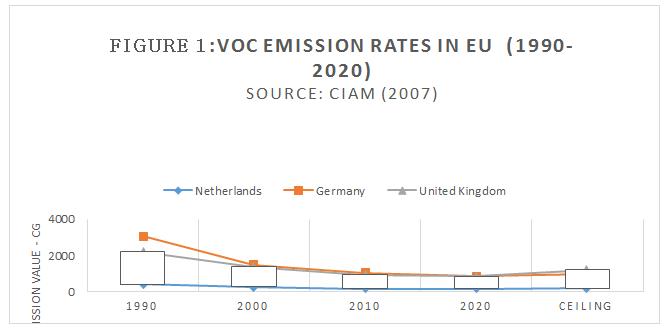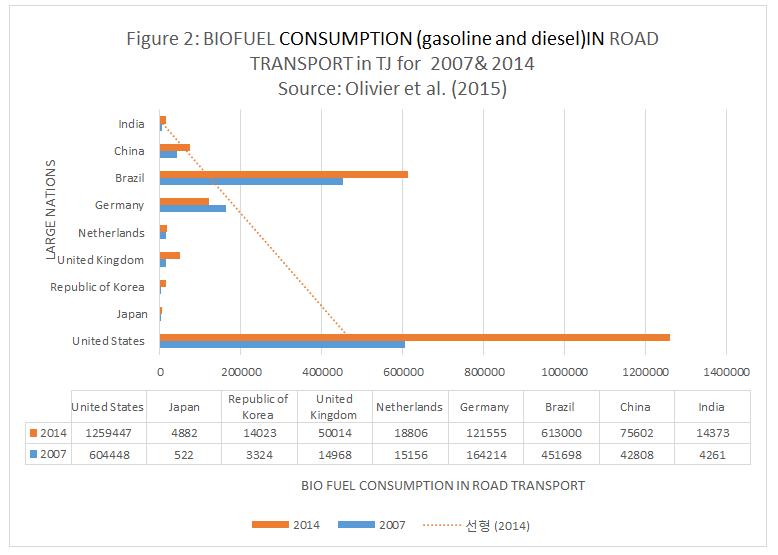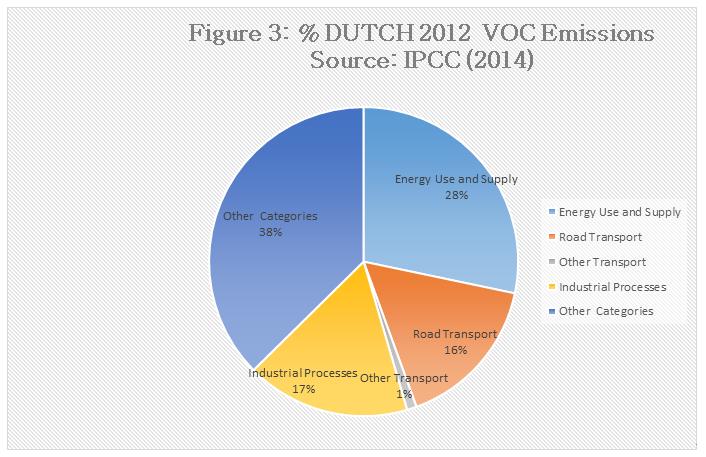The Dutch Policy in Reducing VOC Emissions
- Date2016-06-22 00:00
- View1,234
The
Dutch Policy in Reducing VOC Emissions
Lee Suk-Yeoung
& Chandradath Madho
Introduction
All nations of the world contribute to human-induced
emissions of VOC’s. However, the wealthier nations tend to expend large amounts
of energy and transport services. This culminates in high volumes of VOC
emissions which pose health risks to humans who may inhale noxious fumes. Also,
VOC emissions enhance the concentration of ozone in the earth’s lower
atmosphere. Hence, a few developed nations, like The Netherlands have
conscientiously pursued the agenda of a reduction in their VOC emission rates,
long before the Kyoto Protocol-1997 and the Rio Earth Summit-1992.
Dutch VOC-Reduction Policy
The
VOC-reduction policy in The Netherlands has been two-fold (Ministry of
Infrastructure and the Environment 2016). Firstly, there has been a concerted
effort by the State to improve local air quality via reduced ozone formations
and diminished benzene emissions The second strategy has involved limiting the
carbon footprint in the atmosphere, through the National Emission Ceiling criteria. The latter approach is less
based upon voluntarism and more etched in the imposition of sanctions upon specifically
targeted industries. Indeed, the emission ceiling has been executed in an
incremental manner since the 1980’s by integrating several stakeholders.
The
emission ceiling was imposed from as early as 1980 when the KWS2000 project policy was conceived,
and came into effect from 1988 (Sluijs, V. Risbey,J. and Ravetz, J.2005). This
plan ambitiously sought to achieve by 2001, a 50% decrease in the 1981 volume
of VOCs. In particular, paint coatings were considered a major source of
pollution. Rigid standards were therefore implemented to diminish the risk of
paint-based emissions. It must be appreciated that the State’s plan was also designed
in a way that incorporated the various 40 industrial sectors that were
notorious for polluting. These sectors were identified as being part of the following
industries: energy, road transport and industrial processing. Genuine attempts
were made by industrialists in oil refineries and in the chemical sector to
check their rate of VOC emissions.
Subsequent
to the year 2000 a more aggressive policy was pursued. The environmental goal
was revised via the National Non-Methane
Reduction Plan. This plan sought to procure an 80% reduction in VOC rates
in 2010, relative to the volume of VOC emissions generated in 1980. The
chartered ceiling of emissions was set at 185 CG.
It
was not long after 2010 that the Gothenburg
Proposal was revised in May 2012. This once again propelled the State to re-define
its target as an 8% reduction in VOC emissions, relative to the emission
volumes of 2005. The emission ceiling was therefore set at 158 CG. Interestingly, the Gothenburg Protocol was
drafted in 1999 as an EU directive within a larger framework on the Convention on Long Range Trans-boundary Air
Pollution which seeks to enhance aspects of environmental health. The fact
that the Dutch Government conforms to this protocol indicates that Netherlands
is drawn into an intricate regional agreement that obligates its employers and
citizens to act in a pro-environmental manner. For example, Dutch companies are
mandated by EU directives to comply with VOC-reducing techniques in order to
get their operating licenses to conduct business. These companies are also
monitored on an annual basis, to meet stringent environmental standards.
Failure to meet these criteria could result in the imposition of large fines.
Whilst
the national emission ceilings introduced in different decades generated
environmental compliance, other legal instruments were given salience by the
State. According to VROM (2002: 20): “Dutch Emission Guidelines, orders in
Council pursuant to Section 8.40 of the Environmental Management Act for
certain industrial sectors, environmental permit issues by Provinces and municipalities, emission standards for
transport traffic” have all been useful in reducing air pollution.
The
Dutch have sought to alleviate VOC emissions via an ongoing united approach
that encompasses various stakeholders: manufacturing industries, workplace
settings, households, and the transport sector. For example, all Dutch companies
are mandated to register for specific permits as part of an Activities Decree. If companies are
deemed to be involved in medium or high levels of combustion, they are expected
to be labelled as Type B and Type C companies respectively. Provision of
information to the State about levels of combustion of fossil fuels has been
mandatory, and crucial for the monitoring of emissions. This system has been in
place since 1992.
Meanwhile,
households and companies can also counter possibilities of VOC emissions by
restricting their usage of VOCs. This has been based on the Dutch ratification
of the EU VOC Product Directive. The
most significant example of the EU product Directive is based on the EU Paints
Directive of 2004. This dictate obligates paint manufacturers to clearly label
their paint solvents in terms of the lower and upper levels of acceptable VOC
percentage within the paint solvent and also, the percentage of VOC content
contained. Through product labelling, it is envisioned that consumers may make
an informed choice about regulating the VOC emissions.
Dutch
and EU products are being manufactured to reduce their likelihood of becoming
volatile. Whilst this a notable achievement, it is tough to impose sanctions on
non-EU merchandise. Hence, the general public is expected to be careful about
making purchases of foreign products. This requires a level of environmental
awareness by the Dutch public.
Outcomes of the Dutch
VOC Policy
In the initial period of the 1980s to 1999 the KWS 2000 Project achieved a 50%
reduction in VOC emission rates. This was especially laudable, since the start
of this intervention preceded the Kyoto Protocol of 1997 and EU environmental
legislation. Perhaps buoyed by the initial success, the VOC National Reduction Plan (excluding methane) in 2000 was more
aggressively pursued. It therefore resulted in a 34% reduction in VOC
emissions. In the current era of post- Gothenburg Protocol, the reduction
target of 158 CG by 2020 is projected to be attained because of the State’s
partnering with ships and oil-tank vessel companies.
The early decades of VOC-reduction did not
warrant compliance from the shipping sector. Whilst the energy companies and
manufacturing plants located on land-sites were being monitored, there was
little attention placed on auditing the pollution rates of ships. This
situation has now changed, as the logistic resources and personnel required for
monitoring and evaluation of Dutch VOC emissions have improved. This highlights
an evolution in the State’s capacity to mitigate against VOC-related pollution.
This State’s capacity has been buffered by the commitment of the EU agenda to
reduce VOC emissions.
With reference to Figure 1 shown below,
Netherlands has managed to have lower emissions than rivalling manufacturing
giants like Germany and United Kingdom. All three countries have experienced
reductions in VOC emissions prior to the Gothenburg Protocol acceptance (CIAM
2007). This shows that genuine progress has been made by Netherlands and its EU
trading rivals in reducing VOC emissions.

It may be the case that the reduction in VOC
emissions is largely due to EU related policies that are generally directed at
industrial compliance to air emission protocols. For example, the 2010 Industrial Emissions Directive (IED)
20110/75 states that the nation-states like The Netherlands must be ready
to issue industrial permits in a manner that thoroughly checks on the general
ability of a company to reduce environmental pollution. Although a permit is
granted on a series of factors that includes the ability of a company to reduce
its VOC emissions among other factors, there is no denying the IED has created
pressure for industrial manufacturing plants to be more eco-friendly.
In attributing the success of VOC reductions
over the past three decades, Netherlands’ capacity to demand cooperation from
private companies has been crucial.
These companies have voluntarily demonstrated sound corporate
citizenship because they have accessed available technologies to reduce
emission; an operational cost that is incurred by these companies. It may not
be likely that developing countries or relatively poorer East-European EU
nations enjoy similar institutional strengths to diminish VOC emissions.
Additionally in explaining the success of the
Dutch model of VOC reduction it must be conceded that the State was not the
sole actor dictating the policy. International Conventions like the Kyoto
Protocol and the Copenhagen Climate Change Protocol may have applied subtle
forms of normative, global pressure, in order to locate VOC reduction within
the framework of sustainable development. This is evidenced in Netherlands’
reduction in biofuel (gasoline and diesel) consumption, which may showcase that
Dutch vehicle owners are becoming more environmentally aware of the usage of
bioethanol and biodiesel. As the Dutch use intra-city trams, inter-city trains
and cycling as modes of transport, it is not surprising that the Dutch are
outperforming European rivals in bio-fuel cut-backs. In fact the Dutch are also
performing better than large developed economies like the USA, and emerging
market economies like Brazil because these countries have larger populations
that leave a larger carbon footprint on the atmosphere. Although India seems to
consume less biofuel than The Netherlands, this statistic may be inaccurate or
unreliable, since measurement of consumption-statistics is often
under-estimated in developing countries. However, there is need to be cautious
about celebrating the Dutch reduction in VOC emissions, when compared to their
economic competitors.

[Source: Olivier et al 2015]
According to Figure 3 shown below, The
Netherlands has been polluting the atmosphere with VOC emissions via the Energy
Use & Transport Sector (28%) and the Road Transport Sector (16%). Even if motor-vehicle
bio-fuel consumption (gasoline and diesel) is lower than other countries, the
Dutch policies about reducing VOC emissions must not be relaxed. This means
that Netherlands must continue to find solutions to downsize their carbon
footprint.

[Source: Intergovernmental Panel on Climate Change (IPCC) 2014]
Suggestions about
further reductions in VOC emissions
The road- transport sector’s contribution to
pollution could be further reduced if incentives were given to encourage a
higher use of trams and trains by civilians. Such a plan will stimulate a
reduced usage of cars. However, the public transport services are currently
very expensive, and may repel citizens from reliance upon these services. The
Government should therefore seek to provide a tax break as an incentive to public
transport companies that reduce the fares for the use of trams and trains.
Another way of countering VOC emissions is to
encourage the teaching of environmental studies within the public school’s
curriculum. By infusing relevant life-long lessons about the sources of VOC
compounds and their associated dangers, there is a great likelihood that children
would transmit this information to families. Also, the Government needs to
engage with the mass media and social media more proactively, to warn citizens
and workplaces about the risks associated with using paint solvents in
particular and also about the benzene content contained in cigarette smoke.
CONCLUSION
In general, The Netherlands has successfully reduced
VOCs due to the confluence of EU regulations, international conventions and
Dutch indigenous policy making. This united
agenda must continue if greater strides are to be made. In the aftermath of the
2015 Paris Climate Convention, The Netherlands should be encouraged to provide
technical assistance to developing and rich nations, regarding monitoring and
regulation of VOCs.
References
[1] British Broadcasting
Company (BBC) (2015) ‘Netherlands ordered to cut greenhouse gas emissions’ 24
June 2015 Issue. Accessed 26 May 2016 < http://www.bbc.com/news/world-europe-33253772>.
[2] Centre for Integrated
Assessment Modelling (CIAM) (2007) Review
of the Gothenburg Protocol. Bilthoven: Netherlands Environmental Agency.
Accessed May 26 2016 <www.emep.int/publ/other/TFIAM_ReviewGothenburgProtocol.pdf>.
[3] European
Commission (2010) The Industrial
Emissions Directive 2010/75/EU. Accessed 26 May 2016 < http://ec.europa.eu/environment/industry/stationary/ied/implementation.htm>.
[4] European
Environment Agency (EEA) (2016) Air
Pollution Fact Sheets 2014. Copenhagen: European Environmental Agency.
Accessed 26 May 2016 <http://www.eea.europa.eu/downloads/d838969a52594e3d919437113e98b626/1458048360/air-pollution-country-fact-sheets-2014.pdf.>
[5] Goldstein, A.,
Galbally, I.E. (2007) ‘Known and Unexplored Organic Constituents in the Earth's
Atmosphere’, Environmental Science &
Technology: 41(5):1514?21. 17396635.
[6] Intergovernmental
panel on Climate Change (IPCC) (2014) Climate
Change 2014: Synthesis Report. Contribution of Working Groups I, II and III to
the Fifth Assessment Report of the Intergovernmental Panel on Climate Change.
Accessed 26 May 2016 <https://www.ipcc.ch/ipccreports/tar/wg1/140.htm>.
[7] Keller, M., &
Lerdau, M. (1999) ‘Isoprene emission from tropical forest canopy leaves’,Global Biogeochemical Cycles, 13(1): 19-29.
[8] Ministerie van Volkshuisvesting, Ruimtelijke Ordening
en Milieubeheer (VROM)(2002) Emission ceiling acidification and
continental air pollution report of the Netherlands. Accessed 26 May 2015 <http://ec.europa.eu/environment/archives/air/pdf/200181_progr_nl.pdf>.
[9] Ministry of
Infrastructure and the Environment, Government of the Netherlands (2016)
Volatile Organic Compounds. Accessed on 24 May <http://rwsenvironment.eu/subjects/air/volatile-organic/>.
[10] Olivier, J.
Jenssens-Maenhout, G., Muntean, M. and Peters J. (2015) Trends in Global Emissions. The Hague: PBL Netherlands Environmental Agency. Accessed
26 May 2016<http://www.pbl.nl/sites/default/files/cms/publicaties/pbl-2015-trends-in-global-co2-emisions_2015-report_01803.pdf>.
[11] Van Der Sluijs, J.
P., Risbey, J. S., & Ravetz, J (2005) ‘Uncertainty assessment of VOC
emissions from paint in the Netherlands using the NUSAP system’, Environmental
monitoring and assessment 105 (1-3): 229-259.
* Introduced here is an
article written by one of KEI's environment correspondents. KEI invites
students studying abroad and researchers working for foreign research
institutes to send articles on various global environmental issues.
- PrevThe Dutch Environmental Welfare System
- Next[Climate Change] Adoption of the Paris Agreement by the Conference of the Parties (COP) - December 2..
